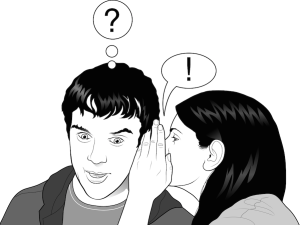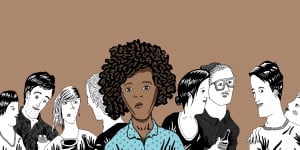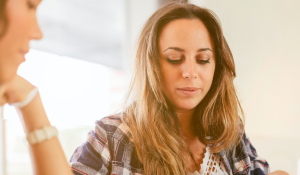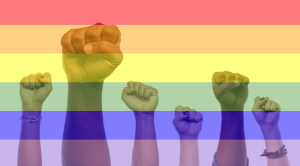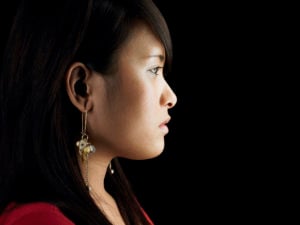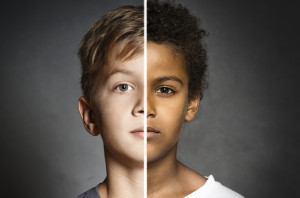There’s something about seeing yourself in a mirror.
Stare long enough, and suddenly it feels like there’s another person in the room looking back at you.
And because I experience dissociation, this disconnect happens quickly and easily, especially on days when I feel the least like myself.
For the longest time, when I was feeling outside myself, depressed, or anxious, I avoided mirrors. However, recently, I’ve begun to do just the opposite.
It started this week.
I felt the warm hands of depression wrap around my eyes, my mouth, my chest, my legs – and the only thing I was capable of doing was opening up my computer.
On a whim, I opened up Photobooth, my Mac’s image-capturing program. The light was shining brighter than usual through my kitchen window, and instead of turning away from it, I checked out how it would make my cheek bones look.
Half an hour later, I was waist-deep in self-portraits.
It seemed the longer I held my own gaze, the more I started to appreciate the face in front of me. I began photographing bits and parts of my body: a series of lips, a series of collarbones, a series of eyes.
And the more I looked at my own face, the more I was able to detach myself from my own judgments against myself.
In a flurry of depression and dissociation, I became fascinated with the person in front of me. They were sad and tired and beautiful, and I couldn’t stop photographing them.
I began to fall in love with myself in the way I would fall in love with a stunningly tragic heroine, an oil painting of an unnamed woman, or a particularly well-captured still from my favorite movie –freely and openly
I knew from other loves of mine that what would make me happy was to see personality traits, tics, body language particular to my subject. So I kept shooting, shot after shot of my nervous habits: my tongue hanging out of my mouth as I look away from a friend listening intently, my overgrown nails picking at my raw skin, the bags under my eyes at three in the afternoon.
Neurodivergent and mentally disabled people are constantly being told not to romanticize their “symptoms” or disabilities, for able-minded and able-bodied folks are afraid that loving those parts of ourselves will result in a decay in our health and well-being.
But I was beginning to have a love affair with my sadness, and that love was bringing me closer to the surface than I had been in weeks.
Now, these self-portraits weren’t romanticizing my actual depression, per se, so much as they were romanticizing my body’s expression of this depression – and this felt like freedom.
I couldn’t stop my mind from dipping into depression, but I could change the way I saw myself during these downswings. I couldn’t stop myself from picking at my skin, but I could make this pock marked face feel beautiful again.
As selfie culture continues to make its mark on our current social environment, I feel a deep-seated desire to force our conversations around modern self-portraiture to continue as well.
Self-portraits are – and always have been, artistically – tools of self-empowerment, of self-discovery, of documentation. But I have found that they can also be a form of therapy and self-care.
I can use seflies to document when my hair looked its best, when my makeup was particularly amazing, or when my outfit slayed men in the streets. But I have also felt a deep sense of self-satisfaction in depicting the deep colors of my tired eyes, the unique and personal ways my skin folds as I frown, and the fingerprints of acne scars and ingrown hairs along my jaw.
It’s important to share our beauty when we feel beautiful – but I find it even more important to share our beauty when we don’t feel beautiful.
So here are some ways that you, especially in mental health repair, can turn your seflies into self-care:
1. Reclaim What’s Been Deemed Undesirable
When you deal with mental disability or neurodivergence on a daily basis, it can show up on your body.
Insomnia becomes under-eye bags, executive dysfunction becomes unwashed hair, tics and stims become bleeding cuticle beds and acne scarred faces.
These parts of ourselves are labeled “undesirable” by our current mainstream beauty standards. These are the parts of ourselves we are told to hide.
But when you’re mentally disabled or neurodivergent, you can lack the ability to put in the work to mask these parts of yourself – and more importantly, you shouldn’t have to.
So, I say, go photograph what you deem your worst physical quality. Get some nice close-ups of your zits, throw some glitter on those under eye bags, and recontextualize what those parts of your body mean.
Every part of your body is beautiful, sometimes there are just areas of yourself that need to be reminded of that.
2. Stylize Your ‘Imperfections’
One of the ways I’d always tried to deal with “imperfections” in my face or body (read: what society deems as imperfections) was by covering up or ignoring them.
When I’ve tried to ignore them, every time I see a mirror or catch a glimpse of my reflection, it only works to make my mental state worse. I’m thrown back and suddenly remember that those aspects of myself are still there – and it only makes me feel worse about myself.
But when you can bring attention to these particular parts of yourself, normalize them to yourself, even celebrate them, they don’t have the same power over you as they once did.
The first time I experimented with this idea of stylizing my “imperfections” was when I got a piercing (across the bridge of my nose), specifically to bring attention to my unibrow.
This piercing made me love this aspect of myself. When I saw it, I loved it – and over a certain period of time, I learned to absolutely love this part of myself that I used to hate.
Taking pictures of yourself that are stylized and fun that emphasize parts of yourself that you would normally shy away from can help you become familiar with those “imperfections.”
So take a picture that, when you look at it, shows great lighting, an awesome pose, great props, and those stellar zits.
These don’t have to be pictures that you post on Instagram or Tumblr or Facebook – although they certainly can be. These can be your own personal collection of self-portraits if you want. But these self-portraits have the potential to refamiliarize yourself with parts of your body that you otherwise shy away from.
Putting them in the spotlight, at least for your own viewing pleasure, can take those characteristics that you used to avoid at all costs and make them friendly features of your gorgeous self.
And when you become familiar with these parts of yourself, catching a glimpse of them in the mirror can cease to be as shocking and anxiety-inducing as they used to.
Monobrows, wirey hairs spilling out above your lip, pimples dotting your cheeks, bags holding sadness and exhaustion sitting under your blood shot eyes. Here, you are beautiful.
Fill your gaping pores with compliments, shoot your stubble in the best lighting you can find, and understand that the bags under your eyes are more unique, rare, and precious than any studded leather work.
3. Fall in Love with Yourself
When you’re struggling with mental disabilities that take away your ability to connect with yourself or others, it can be hard to feel anything but contempt for yourself and the way you look.
And when I say “love yourself,” I don’t mean it in the “Drink water! Take a bath! Think positive!” way – the way that so many neurotypical folks tell mental disabled or neurodivergent folks to “get over” their differences or disabilities.
When I say “fall in love with yourself,” I mean “begin to see yourself as a work of art.”
You don’t need to pull yourself out of your negative thinking with a seflie. In fact, I think that’s probably impossible to do (or else we could package and sell Instagram in pharmacies). But I think that it’s possible to begin to see your body, your face, your being as something that’s beautiful just the way that it is.
When you love someone, whether it’s the intimate love for a friend or a partner or an infatuated love with a character or celebrity, it’s easier to forgive those people for their flaws.
Sometimes we can even see these people as even more lovable or endearing when they have a couple of zits on their face or have greasy hair for lack of showering. It gives them depth, nuance, character.
So, why not see these things within yourself?
Like I mentioned above, the more photos I took of myself, the more I began to see my face as that of a painting, a character, a movie still.
And seeing myself this way made it easier for me to embrace that which made my face unique.
***
While many people would deem this sort of self-expression repulsive in the way that it idealizes “unhealthy” images of the self, these people have probably never experienced disability or neurodivergence.
It’s objectively false to claim that healthy bodies, faces, and minds can only be attributed to certain looks or lifestyles.
For me, getting out of bed at all is being my healthiest. Eating a sleeve of cookies instead of nothing at all is being my healthiest. And sometimes crying is the best workout I could give my body and my mind.
And I want to express and experience my full self.
So open up your computer, if you can, and begin to refamiliarize yourself with your face and body. Maybe soon you’ll even find yourself loving what you see.
[do_widget id=’text-101′]
Kris Nelson is a writer who runs a blog full of short queer-centric radical prose and a YouTube channel called The Whispering Witch, focused on uplifting guided meditations and relaxation videos. Kris also runs an online store by the name of SpellBoundTreasures, where they strive to bring magic into the world through crystal jewelry and herbal remedies. They can be contacted on Tumblr or at [email protected].
Search our 3000+ articles!
Read our articles about:
Our online racial justice training
Used by hundreds of universities, non-profits, and businesses.
Click to learn more






